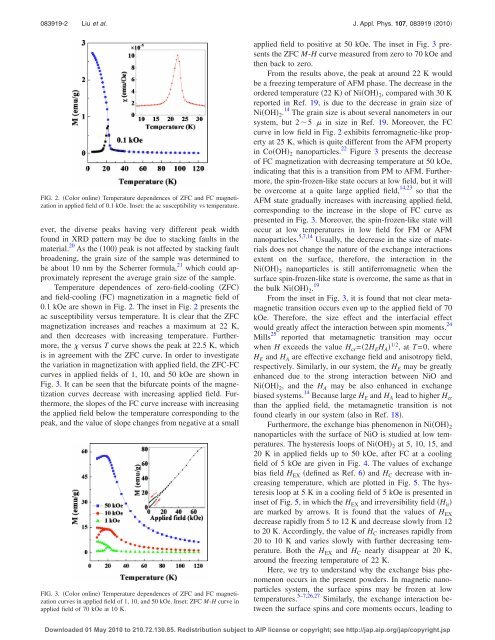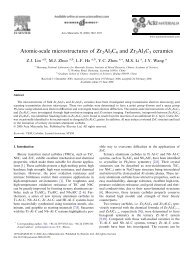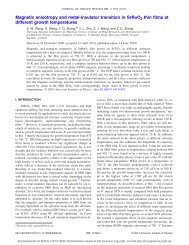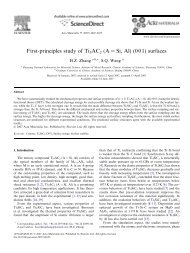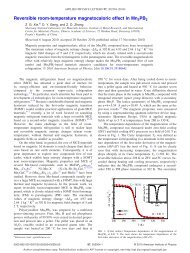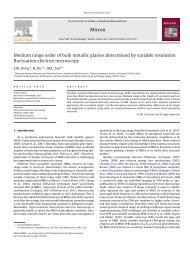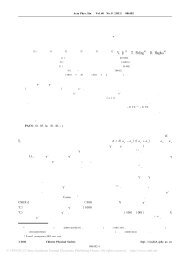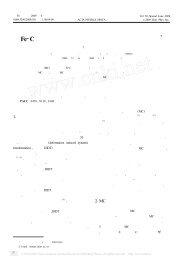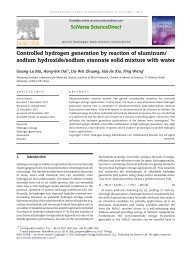Magnetic properties of nickel hydroxide nanoparticles
Magnetic properties of nickel hydroxide nanoparticles
Magnetic properties of nickel hydroxide nanoparticles
You also want an ePaper? Increase the reach of your titles
YUMPU automatically turns print PDFs into web optimized ePapers that Google loves.
083919-2 Liu et al. J. Appl. Phys. 107, 083919 2010<br />
FIG. 2. Color online Temperature dependences <strong>of</strong> ZFC and FC magnetization<br />
in applied field <strong>of</strong> 0.1 kOe. Inset: the ac susceptibility vs temperature.<br />
ever, the diverse peaks having very different peak width<br />
found in XRD pattern may be due to stacking faults in the<br />
material. 20 As the 100 peak is not affected by stacking fault<br />
broadening, the grain size <strong>of</strong> the sample was determined to<br />
be about 10 nm by the Scherrer formula, 21 which could approximately<br />
represent the average grain size <strong>of</strong> the sample.<br />
Temperature dependences <strong>of</strong> zero-field-cooling ZFC<br />
and field-cooling FC magnetization in a magnetic field <strong>of</strong><br />
0.1 kOe are shown in Fig. 2. The inset in Fig. 2 presents the<br />
ac susceptibility versus temperature. It is clear that the ZFC<br />
magnetization increases and reaches a maximum at 22 K,<br />
and then decreases with increasing temperature. Furthermore,<br />
the versus T curve shows the peak at 22.5 K, which<br />
is in agreement with the ZFC curve. In order to investigate<br />
the variation in magnetization with applied field, the ZFC-FC<br />
curves in applied fields <strong>of</strong> 1, 10, and 50 kOe are shown in<br />
Fig. 3. It can be seen that the bifurcate points <strong>of</strong> the magnetization<br />
curves decrease with increasing applied field. Furthermore,<br />
the slopes <strong>of</strong> the FC curve increase with increasing<br />
the applied field below the temperature corresponding to the<br />
peak, and the value <strong>of</strong> slope changes from negative at a small<br />
FIG. 3. Color online Temperature dependences <strong>of</strong> ZFC and FC magnetization<br />
curves in applied field <strong>of</strong> 1, 10, and 50 kOe. Inset: ZFC M-H curve in<br />
applied field <strong>of</strong> 70 kOe at 10 K.<br />
applied field to positive at 50 kOe. The inset in Fig. 3 presents<br />
the ZFC M-H curve measured from zero to 70 kOe and<br />
then back to zero.<br />
From the results above, the peak at around 22 K would<br />
be a freezing temperature <strong>of</strong> AFM phase. The decrease in the<br />
ordered temperature 22 K <strong>of</strong> NiOH 2 , compared with 30 K<br />
reported in Ref. 19, is due to the decrease in grain size <strong>of</strong><br />
NiOH 2 . 14 The grain size is about several nanometers in our<br />
system, but 25 in size in Ref. 19. Moreover, the FC<br />
curve in low field in Fig. 2 exhibits ferromagnetic-like property<br />
at 25 K, which is quite different from the AFM property<br />
in CoOH 2 <strong>nanoparticles</strong>. 22 Figure 3 presents the decrease<br />
<strong>of</strong> FC magnetization with decreasing temperature at 50 kOe,<br />
indicating that this is a transition from PM to AFM. Furthermore,<br />
the spin-frozen-like state occurs at low field, but it will<br />
be overcome at a quite large applied field, 14,23 so that the<br />
AFM state gradually increases with increasing applied field,<br />
corresponding to the increase in the slope <strong>of</strong> FC curve as<br />
presented in Fig. 3. Moreover, the spin-frozen-like state will<br />
occur at low temperatures in low field for FM or AFM<br />
<strong>nanoparticles</strong>. 5,7,14 Usually, the decrease in the size <strong>of</strong> materials<br />
does not change the nature <strong>of</strong> the exchange interactions<br />
extent on the surface, therefore, the interaction in the<br />
NiOH 2 <strong>nanoparticles</strong> is still antiferromagnetic when the<br />
surface spin-frozen-like state is overcome, the same as that in<br />
the bulk NiOH 2 . 19<br />
From the inset in Fig. 3, it is found that not clear metamagnetic<br />
transition occurs even up to the applied field <strong>of</strong> 70<br />
kOe. Therefore, the size effect and the interfacial effect<br />
would greatly affect the interaction between spin moments. 24<br />
Mills 25 reported that metamagnetic transition may occur<br />
when H exceeds the value H cr =2H E H A 1/2 ,atT=0, where<br />
H E and H A are effective exchange field and anisotropy field,<br />
respectively. Similarly, in our system, the H E may be greatly<br />
enhanced due to the strong interaction between NiO and<br />
NiOH 2 , and the H A may be also enhanced in exchange<br />
biased systems. 14 Because large H E and H A lead to higher H cr<br />
than the applied field, the metamagnetic transition is not<br />
found clearly in our system also in Ref. 18.<br />
Furthermore, the exchange bias phenomenon in NiOH 2<br />
<strong>nanoparticles</strong> with the surface <strong>of</strong> NiO is studied at low temperatures.<br />
The hysteresis loops <strong>of</strong> NiOH 2 at 5, 10, 15, and<br />
20 K in applied fields up to 50 kOe, after FC at a cooling<br />
field <strong>of</strong> 5 kOe are given in Fig. 4. The values <strong>of</strong> exchange<br />
bias field H EX defined as Ref. 6 and H C decrease with increasing<br />
temperature, which are plotted in Fig. 5. The hysteresis<br />
loop at 5Kinacooling field <strong>of</strong> 5 kOe is presented in<br />
inset <strong>of</strong> Fig. 5, in which the H EX and irreversibility field H ir <br />
are marked by arrows. It is found that the values <strong>of</strong> H EX<br />
decrease rapidly from 5 to 12 K and decrease slowly from 12<br />
to 20 K. Accordingly, the value <strong>of</strong> H C increases rapidly from<br />
20 to 10 K and varies slowly with further decreasing temperature.<br />
Both the H EX and H C nearly disappear at 20 K,<br />
around the freezing temperature <strong>of</strong> 22 K.<br />
Here, we try to understand why the exchange bias phenomenon<br />
occurs in the present powders. In magnetic <strong>nanoparticles</strong><br />
system, the surface spins may be frozen at low<br />
temperatures. 5–7,26,27 Similarly, the exchange interaction between<br />
the surface spins and core moments occurs, leading to<br />
Downloaded 01 May 2010 to 210.72.130.85. Redistribution subject to AIP license or copyright; see http://jap.aip.org/jap/copyright.jsp


